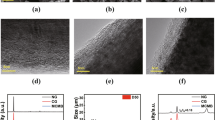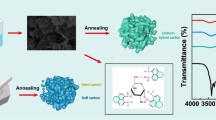Abstract
This paper presents a novel approach for optimizing potassium-ion battery electrode materials. By employing a pre-bonding technique, we have effectively combined the strengths of hard carbon’s rapid potassium-ion adsorption and graphite’s extensive potassium storage. The resulting pre-bonded carbon (PBC) composite exhibits remarkable electrochemical performance with exceptional stability. Electrochemical characterizations, along with SEM, Raman, XRD, and macroscopic observations, provide insights into PBC’s advantages. PBC’s structural integrity, maintained even after extended cycling, highlights its capacity to protect the graphite structure from damage. This buffering effect is especially significant under high current conditions. Furthermore, the pre-bonding process enables PBC to store potassium effectively, ensuring a high energy density for the negative electrode material. In contrast, samples mixed without pre-bonding exhibit poor adhesion between hard carbon and graphite, leading to graphite breakage and reduced electrochemical performance. PBC’s simplicity of implementation and compatibility with existing production systems make it a valuable addition to potassium-ion battery development, particularly in large-scale energy storage applications. The findings underscore the significance of pre-bonding as a promising technique to optimize potassium-ion battery electrode materials.







Similar content being viewed by others

Data availability
The data used to support the findings of this study are available from the corresponding author upon request.
References
Y. Xu, M. Titirici, J. Chen, F. Cora, P.L. Cullen, J.S. Edge, K. Fan, L. Fan, J. Feng, T. Hosaka, J. Hu, W. Huang, T.I. Hyde, S. Imtiaz, F. Kang, T. Kennedy, E.J. Kim, S. Komaba, L. Lander, P.N. Le Pham, P. Liu, B. Lu, F. Meng, D. Mitlin, L. Monconduit, R.G. Palgrave, L. Qin, K.M. Ryan, G. Sankar, D.O. Scanlon, T. Shi, L. Stievano, H.R. Tinker, C. Wang, H. Wang, H. Wang, Y. Wu, D. Zhai, Q. Zhang, M. Zhou, J. Zou, Roadmap for potassium-ion batteries. J. Phys. Energy 5, 021502 (2023). https://doi.org/10.1088/2515-7655/acbf76
Y. Liu, Y.-X. Lu, Y.-S. Xu, Q.-S. Meng, J.-C. Gao, Y.-G. Sun, Y.-S. Hu, B.-B. Chang, C.-T. Liu, A.-M. Cao, Pitch-derived soft carbon as stable anode material for potassium ion batteries. Adv. Mater. 32, 2000505 (2020). https://doi.org/10.1002/adma.202000505
Y. An, H. Fei, G. Zeng, L. Ci, B. Xi, S. Xiong, J. Feng, Commercial expanded graphite as a low-cost, long-cycling life anode for potassium-ion batteries with conventional carbonate electrolyte. J. Power Sour. 378, 66–72 (2018). https://doi.org/10.1016/j.jpowsour.2017.12.033
T. Hosaka, K. Kubota, A.S. Hameed, S. Komaba, Research development on K-ion batteries. Chem. Rev. 120, 6358–6466 (2020). https://doi.org/10.1021/acs.chemrev.9b00463
S. Liu, L. Kang, J. Henzie, J. Zhang, J. Ha, M.A. Amin, M.S.A. Hossain, S.C. Jun, Y. Yamauchi, Recent advances and perspectives of battery-type anode materials for potassium ion storage. ACS Nano 15, 18931–18973 (2021). https://doi.org/10.1021/acsnano.1c08428
F. Yang, H. Chen, J. Guo, P. Zheng, Catalytic graphitization of anthracite-derived carbon as the anode for Li/K-ion batteries. J. Mater. Sci.: Mater. Electron. 33, 4862–4868 (2022). https://doi.org/10.1007/s10854-021-07675-8
M. Liu, D. Jing, Y. Shi, Q. Zhuang, Superior potassium storage in natural O/N–doped hard carbon derived from maple leaves. J. Mater. Sci.: Mater. Electron. (2019). https://doi.org/10.1007/s10854-019-01219-x
C. Bommier, T.W. Surta, M. Dolgos, X. Ji, 46-New mechanistic insights on Na-ion storage in nongraphitizable carbon. Nano Lett. 15, 5888–5892 (2015). https://doi.org/10.1021/acs.nanolett.5b01969
V. Lakshmi, Y. Chen, A.A. Mikhaylov, A.G. Medvedev, I. Sultana, M.M. Rahman, O. Lev, P.V. Prikhodchenko, A.M. Glushenkov, Nanocrystalline SnS 2 coated onto reduced graphene oxide: demonstrating the feasibility of a non-graphitic anode with sulfide chemistry for potassium-ion batteries. Chem. Commun. 53, 8272–8275 (2017). https://doi.org/10.1039/C7CC03998K
X. Chen, C. Liu, Y. Fang, X. Ai, F. Zhong, H. Yang, Y. Cao, Understanding of the sodium storage mechanism in hard carbon anodes. Carbon Energy. 4, 1133–1150 (2022). https://doi.org/10.1002/cey2.196
D.A. Stevens, J.R. Dahn, The mechanisms of lithium and sodium insertion in carbon materials. J. Electrochem. Soc. 148, A803–A811 (2001). https://doi.org/10.1149/1.1379565
Z. Jian, S. Hwang, Z. Li, A.S. Hernandez, X. Wang, Z. Xing, D. Su, X. Ji, Hard–soft composite carbon as a long-cycling and high‐rate anode for potassium‐ion batteries. Adv. Funct. Mater. 27, 1700324 (2017). https://doi.org/10.1002/adfm.201700324
J.R. Dahn, W. Xing, Y. Gao, The falling cards model for the structure of microporous carbons. Carbon. 35, 825–830 (1997). https://doi.org/10.1016/S0008-6223(97)00037-7
Z. Wu, J. Zou, Y. Zhang, X. Lin, D. Fry, L. Wang, J. Liu, Lignin-derived hard carbon anode for potassium-ion batteries: Interplay among lignin molecular weight, material structures, and storage mechanisms. Chem. Eng. J. (2022). https://doi.org/10.1016/j.cej.2021.131547
S.Y. Luchkin, S.A. Lipovskikh, N.S. Katorova, A.A. Savina, A.M. Abakumov, K.J. Stevenson, Solid-electrolyte interphase nucleation and growth on carbonaceous negative electrodes for Li-ion batteries visualized with in situ atomic force microscopy. Sci. Rep. 10, 8550 (2020). https://doi.org/10.1038/s41598-020-65552-6
C. Ge, Z. Fan, J. Zhang, Y. Qiao, J. Wang, L. Ling, Novel hard carbon/graphite composites synthesized by a facile in situ anchoring method as high-performance anodes for lithium-ion batteries. RSC Adv. 8, 34682–34689 (2018). https://doi.org/10.1039/c8ra07170e
K. Chen, V. Goel, M.J. Namkoong, M. Wied, S. Müller, V. Wood, J. Sakamoto, K. Thornton, N.P. Dasgupta, Enabling 6 C fast charging of Li-Ion batteries with graphite/hard carbon hybrid anodes. Adv. Energy Mater. 11, 2003336 (2021). https://doi.org/10.1002/aenm.202003336
K. Kubota, S. Shimadzu, N. Yabuuchi, S. Tominaka, S. Shiraishi, M. Abreu-Sepulveda, A. Manivannan, K. Gotoh, M. Fukunishi, M. Dahbi, S. Komaba, Structural analysis of sucrose-derived hard carbon and correlation with the electrochemical properties for lithium, sodium, and potassium insertion. Chem. Mater. 32, 2961–2977 (2020). https://doi.org/10.1021/acs.chemmater.9b05235
F.G. Emmerich, Evolution with heat treatment of crystallinity in carbons. Carbon. 33, 1709–1715 (1995). https://doi.org/10.1016/0008-6223(95)00127-8
E. Buiel, J.R. Dahn, Li-insertion in hard carbon anode materials for Li-ion batteries. Electrochim. Acta. 45, 121–130 (1999). https://doi.org/10.1016/S0013-4686(99)00198-X
L.G. Cançado, K. Takai, T. Enoki, M. Endo, Y.A. Kim, H. Mizusaki, A. Jorio, L.N. Coelho, R. Magalhães-Paniago, M.A. Pimenta, General equation for the determination of the crystallite size La of nanographite by Raman spectroscopy. Appl. Phys. Lett. 88, 163106 (2006). https://doi.org/10.1063/1.2196057
D. Cheng, X. Zhou, H. Hu, Z. Li, J. Chen, L. Miao, X. Ye, H. Zhang, Electrochemical storage mechanism of sodium in carbon materials: a study from soft carbon to hard carbon. Carbon. 182, 758–769 (2021). https://doi.org/10.1016/j.carbon.2021.06.066
M. Wilamowska, M. Graczyk-Zajac, R. Riedel, Composite materials based on polymer-derived SiCN ceramic and disordered hard carbons as anodes for lithium-ion batteries. J. Power Sour. 244, 80–86 (2013). https://doi.org/10.1016/j.jpowsour.2013.03.137
T.D. Tran, J.H. Feikert, R.W. Pekala, K. Kinoshita, Rate effect on lithium-ion graphite electrode performance. J. Appl. Electrochem. 26, 1161–1167 (1996). https://doi.org/10.1007/BF00243741
D. Jang, S. Suh, H. Yoon, J. Kim, H. Kim, J. Baek, H.-J. Kim, Enhancing rate capability of graphite anodes for lithium-ion batteries by pore-structuring. Appl. Surf. Sci. Adv. 6, 100168 (2021). https://doi.org/10.1016/j.apsadv.2021.100168
Z. Ma, Y. Gao, C. Bao, X. Xia, H. Liu, Reasonable intrinsic microstructure of microcrystalline graphite for high-rate and long-life potassium-ion batteries. Electrochim. Acta 440, 141703 (2023). https://doi.org/10.1016/j.electacta.2022.141703
X. Yi, X. Li, J. Zhong, S. Wang, Z. Wang, H. Guo, J. Wang, G. Yan, Unraveling the mechanism of different kinetics performance between ether and carbonate ester electrolytes in hard carbon electrode. Adv. Funct. Mater. 32, 2209523 (2022). https://doi.org/10.1002/adfm.202209523
E. Woillez, M. Chandesris, Insight into LIB diffusion phenomena using analytical impedance models. J. Electrochem. Soc. 170, 070527 (2023). https://doi.org/10.1149/1945-7111/ace55b
K. Guerin, A. Fevrier-Bouvier, S. Flandrois, B. Simon, P. Biensan, On the irreversible capacities of disordered carbons in lithium-ion rechargeable batteries. Electrochim. Acta. 45, 1607–1615 (2000). https://doi.org/10.1016/S0013-4686(99)00321-7
M.Y. Gu, L. Fan, J. Zhou, A.M. Rao, B.A. Lu, Regulating solvent molecule coordination with KPF6 for superstable graphite potassium anodes. ACS Nano 15, 9167–9175 (2021). https://doi.org/10.1021/acsnano.1c02727
H. Li, W. Li, Improving cycle life and rate capability of artificial graphite anode for lithium-ion batteries by agglomeration. Mater. Lett. 318, 132227 (2022). https://doi.org/10.1016/j.matlet.2022.132227
G. He, L.F. Nazar, Crystallite size control of prussian white analogues for nonaqueous potassium–ion batteries. ACS Energy Lett. 2, 1122–1127 (2017). https://doi.org/10.1021/acsenergylett.7b00179
Funding
This work was generously supported by the National Natural Science Foundation of China (Grant No. 11874124) and the Science and Technology Planning Project of Guangdong Province, China (Grant Nos. 2014B03032013, 2015B010114007, and 2016B010129002).
Author information
Authors and Affiliations
Contributions
RH: Investigation, conceptualization, methodology, writing—original draft, verification, resources, data management, and editing. WW: Writing—review & editing, and visualization. DX: Investigation. LC: Verification. ZF: Visualization and commenting. KW: Commenting and supervision. ZL: Comment and verification. CX: Comment and editing. HM: Funding acquisition.
Corresponding author
Ethics declarations
Conflict of interest
The authors declare that they have no known competing financial interests or personal relationships that could have appeared to influence the work reported in this paper.
Additional information
Publisher’s Note
Springer Nature remains neutral with regard to jurisdictional claims in published maps and institutional affiliations.
Supplementary Information
Below is the link to the electronic supplementary material.
Rights and permissions
Springer Nature or its licensor (e.g. a society or other partner) holds exclusive rights to this article under a publishing agreement with the author(s) or other rightsholder(s); author self-archiving of the accepted manuscript version of this article is solely governed by the terms of such publishing agreement and applicable law.
About this article
Cite this article
Huang, R., Wang, W., Xiong, D. et al. Pre-bonded hybrid carbon materials with stable structure as anode for potassium-ion batteries. J Mater Sci: Mater Electron 35, 317 (2024). https://doi.org/10.1007/s10854-024-12045-1
Received:
Accepted:
Published:
DOI: https://doi.org/10.1007/s10854-024-12045-1



